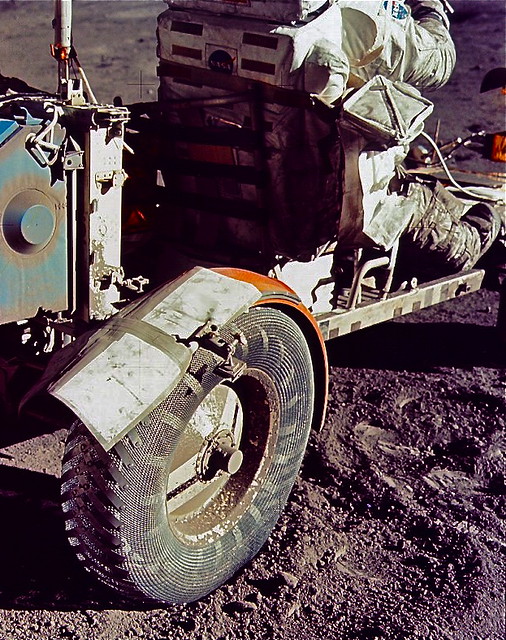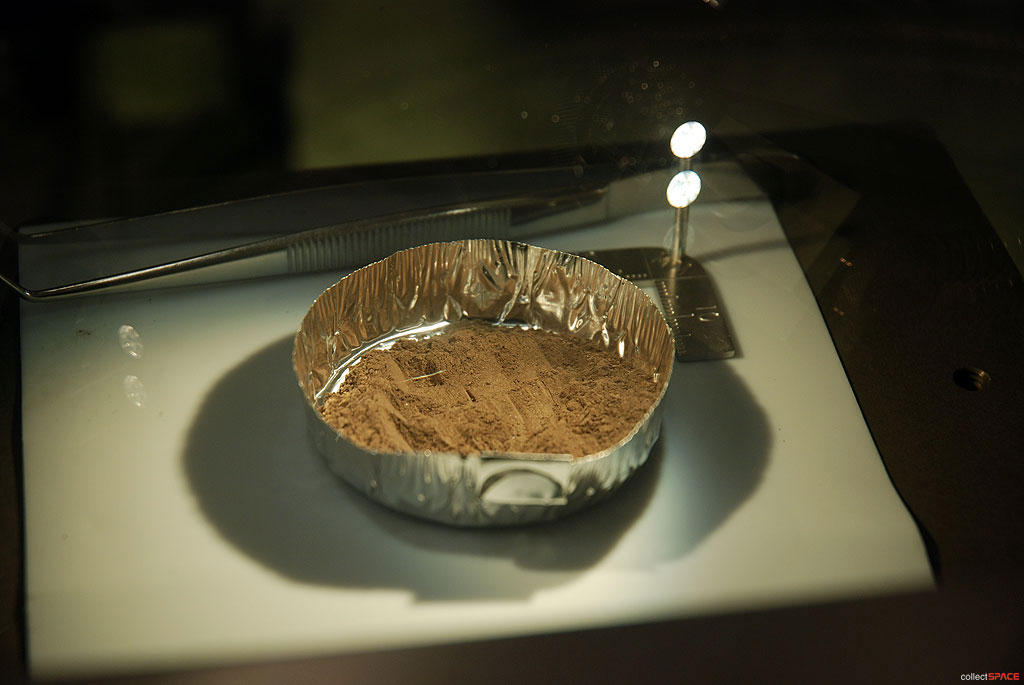Lunar geology however, was at the bleeding edge of science. Eight months before Apollo 17, John Young and Charlie Duke landed in the Descartes Higlands with Apollo 16, briefed for and expecting to find volcanic rocks...and instead found almost nothing but breccias; rocks formed by impact events. Every discovery made from the Moon was significant, whether it proved an existing theory of the Moon or disproved one. Planetary geologists longed for a truly revolutionary find like the 4 billion year-old piece of anorthosite discovered by Apollo 15's Dave Scott and Jim Irwin, known as the "Genesis Rock".
Who better to look for something amazing on man's last voyage to the Moon than the only geologist astronaut? Jack Schmitt was also only one of two geoscientists in the astronaut corps (the other, geophysicist Tony England, had acted as Apollo 16's mission scientist from Mission Control). For an organization focused on the Moon, one would think NASA would have picked up a few more specialists in that area.
Gene Cernan and Schmitt, well rested after their first EVA the day before, depressurized their Lunar Module (LM) Challenger and began EVA-2 at 140:35:06 Ground Elapsed Time (GET)/6:28PM Eastern Standard Time (EST), December 12, 1972 - forty years ago.
Cernan had probably noticed it before, but as he descended to the lunar surface for the second time, he read out loud a note that had been attached to Challenger by one or more of the technicians who prepared her for flight.
140:43:21 Cernan: "Godspeed the crew of Apollo 17." I think I'll read that every time I come down the ladder.One of the first tasks for Cernan and Schmitt was the repair of their Lunar Roving Vehicle's (LRV) broken fender. Without a fix, the two astronauts would be pelted with lunar dust as they drove. While the two lunar explorers rested after EVA-1, a team at Mission Control led by Apollo 16 commander John Young worked on a fix. The solution they came up with was both simple and brilliant. Cernan's temporary repair during EVA-1 showed that the duct tape the astronauts had wouldn't keep the fender together under the dust conditions, but there were a few clamps used inside the LM to hold light fixtures. Cernan and Schmitt were instructed to take their no-longer-needed, plastic-coated geology map cards from EVA-1, tape them together, and clamp the assembly to the remaining portion of the fender. The fix worked, and Cernan and Schmitt proceded to load up the LRV for the day's geology.
 |
| The repaired fender, after about 9 kilometers of driving |
The astronauts were required to start at their intended furthest point from Challenger as a safety measure. Cernan and Schmitt's survival on the surface depended on the consumable resources - water and oxygen - contained in their Portable Life Support System (PLSS) backpacks. Mission rules stated that the two had to have enough consumables at all times to walk back to the LM in case the LRV failed. As the consumables were always decreasing, they had to start at the furthest point away and come back towards Challenger.
Cernan and Schmitt arrived at the base of the South Massif at approximately 142:45. This was Geology Station 2 (Station 1 having been visited during EVA-1). They had stopped en route to place another of the Seismic Profiling Experiment (SPE) explosive charges and gather samples near a crater known as "Camelot". The following video shows some of their Station 2 activities. In it, the astronauts kick over a large rock to sample the soil underneath, shielded for thousands of years by the stone above.
Geology Station 3 at "Ballet" crater was next. The two obtained core samples, took gravimetric readings, and also used the lunar rake to get broad samples.
 |
| Jack Schmitt using the lunar rake to sample soil and rocks |
145:23:48 Schmitt: Okay, Houston. Shorty is clearly a darker-rimmed crater. The inner wall is quite blocky but...Except for the western portion of it, which is less blocky than the others. The floor is hummocky, as we thought it was in the photographs [taken by Apollo 15 from orbit]. The central peak, if you will, or central mound, is very blocky and jagged. And the impression I have of the other mounds in the bottom is that they look like slump masses that may have come off the side.The astronauts' procedure for arriving at a geology station was to give their quick description, as the transcript of Schmitt above shows, and then take a photographic panorama of the area to set the context for the sample collections. Schmitt was working on taking the panorama of the Shorty area when...
145:26:22 Schmitt: Oh, hey! (Very brief pause)
145:26:25 Schmitt: Wait a minute...
145:26:26 Cernan: What?
145:26:27 Schmitt: Where are the reflections? I've been fooled once. [a reflection off of Mylar on the LRV during EVA-1 had made him think he had found colored soil] There is orange soil!!
145:26:32 Cernan: Well, don't move it until I see it.
145:26:35 Schmitt: It's all over!! Orange!!!
145:26:38 Cernan: Don't move it until I see it.
145:26:40 Schmitt: I stirred it up with my feet.
145:26:42 Cernan: Hey, it is!! I can see it from here!
145:26:44 Schmitt: It's orange!
145:26:46 Cernan: Wait a minute, let me put my visor up. It's still orange!
Schmitt observed that the orange soil seemed to be evenly distributed around the rim of the crater and had the appearance of having been oxidized. This was what they were looking for! This could be evidence of more recent (in geologic terms) lunar volcanism altering the surface.
145:28:39 Schmitt: It looks just like an oxidized desert soil, that's exactly right.
145:29:15 Schmitt: You know (pause) that orange is along a line, Geno, along the rim crest.
145:29:27 Cernan: What? Circumferential?
145:29:29 Schmitt: Yeah. Man, if there ever was a [chuckles]...I'm not going to say it. [And then does, anyway] But if there ever was something that looked like a fumarole alteration, this is it.
 |
| The orange soil at Shorty as discovered by Schmitt |
 |
| Orange soil sample post-flight at the Lunar Receiving Laboratory |
 |
| Micrograph of the orange soil |
It turned out upon examination and analysis back on Earth after the flight that the soil wasn't oxidized, nor was it geologically recent. It was colored volcanic glass from fire fountains billions of years before, but was nonetheless an amazing and important discovery! I encourage my readers to go to YouTube and view the other parts of the geology stop at Shorty (1-3 embedded here, there are 7 more parts to the full video).
In between Stations 4 and 5, Cernan and Schmitt placed yet another explosive charge for seismic profiling. Station 5 was their last for the day before returning to the LM. It was on the opposite side of the Camelot crater the two had briefly stopped at on the outbound trip.
The astronauts returned to Challenger at about 147 hours GET. They had a lot of cleanup and "housekeeping" tasks to complete before climbing the ladder into their lunar home. As Cernan climbed up (Schmitt was already inside) he had to do it one handed as he had a box of precious lunar samples in the other.
148:01:32 Cernan: Ohhhh! That's a nice one-handed first step. "Godspeed the crew of Apollo 17". I'm going to keep reading that. I like that message. [Calling to Bob] How's Captain America [meaning Ron Evans], speaking of Apollo 17?
148:01:53 Parker: Captain America is sound asleep. Just about to come around to AOS [Acquisition of Signal when the Command Module emerges from behind the Moon on the current orbit]. We think he's sound asleep.
148:02:00 Cernan: Hey, how does that always happen? That happened yesterday.
148:02:12 Parker: He got up before noon this morning, too.Challenger was repressurized at 148:12:02 and EVA-2 ended. It was 2:05AM EST, December 13, 1972. EVA-2 was the longest moon walk of all Apollo, lasting for 7:36:56.
Man would have just one more chance to explore the lunar surface on foot, beginning in about 15 hours.
Blogger's note: in addition to the sources linked and those mentioned in my previous posts on Apollo 17, I found another tremendous font of information: the Apollo Analyst's Notebook. Thanks to everybody who's taken an interest in preserving the wonder of Apollo's voyages to the Moon!

No comments:
Post a Comment
COMMENTS ARE CLOSED. NO ADDITIONAL COMMENTS WILL BE POSTED HERE. IF YOU WISH TO COMMENT, PLEASE GO TO THE NEW BLOG SITE – http://theirfinesthour.net – AND LEAVE YOUR FEEDBACK THERE!!!
Note: Only a member of this blog may post a comment.